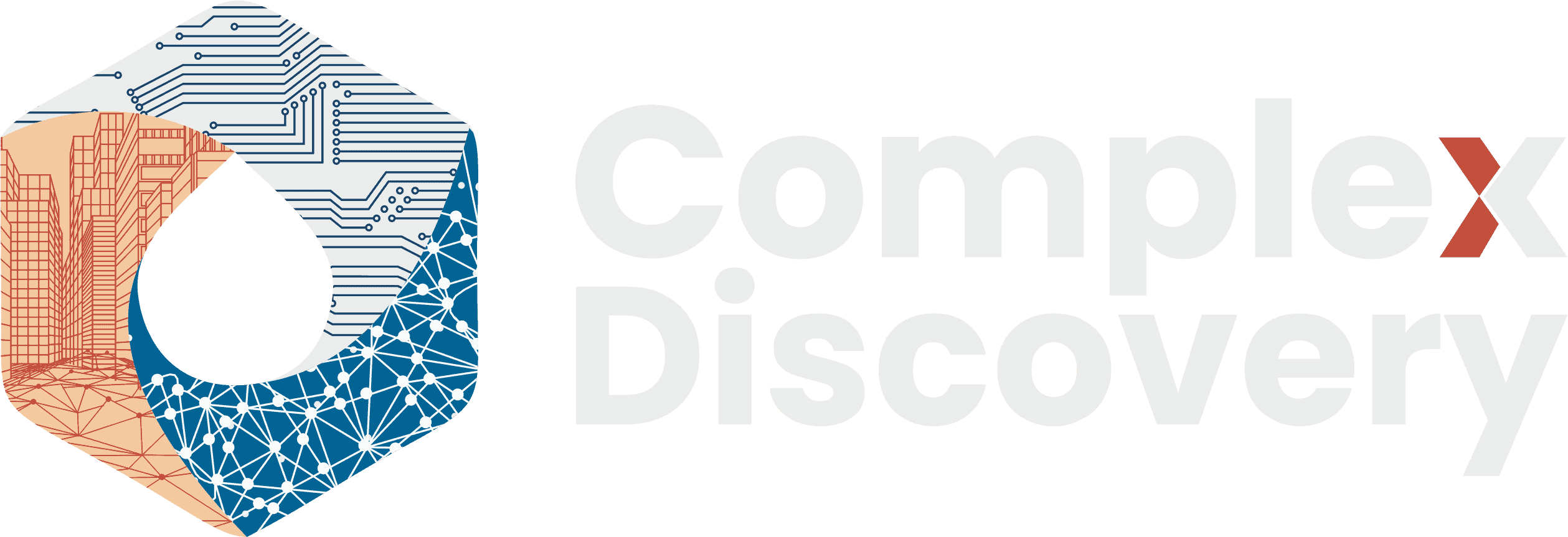Editor’s Note: Pricing transparency has never been more critical in eDiscovery. The Summer 2025 eDiscovery Pricing Survey, produced by ComplexDiscovery OÜ in collaboration with the EDRM, provides a definitive snapshot of current cost structures during one of the most transformative periods in the industry’s history. With detailed input from seventy industry professionals, this benchmark survey spans everything from forensics to generative AI, revealing an ecosystem under pressure from both commoditization and innovation.
This final installment in the 2025 summer pricing survey series offers unique clarity into service areas that are stabilizing and those still struggling to find equilibrium. As AI adoption surges, cross-border matters become routine, and clients demand more predictable pricing, these insights are vital for legal, corporate, and service provider stakeholders seeking to navigate complexity and drive informed decision-making. The survey also honors the late Kaylee Walstad, whose leadership and advocacy for openness continue to shape the future of the profession.
Content Assessment: Industry Benchmarks in an Era of Transformation: The Complete Summer 2025 eDiscovery Pricing Survey
Information - 94%
Insight - 95%
Relevance - 95%
Objectivity - 96%
Authority - 96%
95%
Excellent
A short percentage-based assessment of the qualitative benefit expressed as a percentage of positive reception of the recent article from ComplexDiscovery OÜ titled, "Industry Benchmarks in an Era of Transformation: The Complete Summer 2025 eDiscovery Pricing Survey."
Industry Research
Industry Benchmarks in an Era of Transformation: The Complete Summer 2025 eDiscovery Pricing Survey
ComplexDiscovery Staff
The Summer 2025 eDiscovery Pricing Survey, the latest iteration of the semi-annual pricing benchmark conducted by ComplexDiscovery OÜ in partnership with the EDRM (Electronic Discovery Reference Model), represents one of the industry’s most comprehensive pricing studies during a period of significant technological and economic transformation. With seventy respondents providing insights across twenty-five core pricing questions, this semi-annual survey offers critical data for legal professionals, service providers, and corporate legal departments navigating the evolving economics of electronic discovery.
This final installment synthesizes findings from the complete survey series, providing a consolidated view of pricing across forensics, processing, hosting, review, and emerging generative AI services. The data reveals an industry at an inflection point where mature services face intense commoditization pressure while new technologies introduce both opportunity and uncertainty.
Survey History and Evolution
The eDiscovery Pricing Survey has served as a vital industry benchmark for nearly a decade, evolving from informal polling to systematic data collection that tracks pricing trends across the discovery lifecycle. What began as an effort to bring transparency to an opaque market has become an essential resource for budget planning, vendor negotiations, and strategic decision-making.
The Summer 2025 iteration of this semi-annual survey marks a particularly significant moment in its evolution. Conducted against the backdrop of generative AI adoption, continued remote work normalization, and persistent economic pressures, this survey captures the industry during a period of fundamental transition. The semi-annual cadence allows for tracking both rapid changes and longer-term trends, while the partnership between ComplexDiscovery OÜ and the EDRM ensures both methodological rigor and broad community engagement, lending credibility and reach to the findings that serve practitioners across the ecosystem.
Dedication to Kaylee Walstad
This survey series is dedicated to the memory of Kaylee Walstad, Chief Strategy Officer of the EDRM, whose passing in August 2025 left a profound void in the eDiscovery community. Kaylee’s passionate advocacy for transparency, collaboration, and data-driven decision-making helped shape initiatives like this survey. Her Finnish sisu, that unique combination of strength, determination, and courage, inspired countless professionals across the industry.
“As eDiscovery adapts to rapid technological shifts and mounting regulatory demands, benchmarking pricing is essential,” said Kaylee Walstad on July 9, 2025. “ComplexDiscovery’s survey provides the data we need to understand current costs and prepare for the future. EDRM is proud to support this important resource.”
Her words remind us why systematic pricing research matters as it empowers the entire community to make informed decisions and advance the profession. The collaborative spirit Kaylee championed alongside Mary Mack, CEO and Chief Legal Technologist of the EDRM, continues to guide efforts like this survey.
Survey Demographics: Understanding the Respondent Base
The survey drew overwhelmingly from the United States market, with ninety percent of respondents conducting their eDiscovery business primarily in the U.S. The remaining ten percent represented limited participation from Europe, Canada, and Central/South America. This geographic concentration provides deep insights into the dominant U.S. market while acknowledging limitations in capturing global pricing dynamics that increasingly influence cross-border matters.
Law firms comprised the largest respondent group at forty-three percent, followed closely by software and services providers at thirty-six percent. Together, these two segments accounted for nearly eighty percent of participants, ensuring representation from both the demand and supply sides of the pricing equation. Consultancies contributed ten percent, media, research, and education organizations seven percent, corporations three percent, and government entities one percent. The dominance of law firms and service providers creates a comprehensive view of pricing negotiations, though the minimal corporate representation suggests potential blind spots regarding end-client perspectives on pricing and value.
When examining functional roles, legal and litigation support professionals dominated at sixty-nine percent, with business and business support roles comprising twenty-nine percent, and IT or product development just three percent. This distribution grounds the findings in practical, client-facing experience while potentially underrepresenting technical cost considerations that drive infrastructure and delivery decisions.
Detailed Survey Demographic Analysis with Charts
- Summer 2025 eDiscovery Pricing Trends: Setting the Stage
- The People Behind the Pricing: Respondents to the Summer 2025 eDiscovery Pricing Survey
Forensic Services: The Premium Front Door
Forensic collections demonstrated remarkable pricing consistency, particularly for onsite work, where seventy percent of respondents reported hourly rates between two hundred fifty and three hundred fifty dollars. Only thirteen percent charged above three hundred fifty dollars, while just one percent priced below two hundred fifty dollars. This clustering suggests market maturity and standardization in traditional collection services, where expertise and defensibility command consistent premiums.
Remote collections introduced more variability into the pricing landscape. While sixty-three percent still operated in the two hundred fifty to three hundred fifty dollar band, fourteen percent reported rates under two hundred fifty dollars per hour. Additionally, nine percent cited alternative pricing models, signaling innovation in remote delivery approaches that leverage technology to reduce costs while maintaining quality.
Both desktop/laptop and mobile device collections showed premium orientation, with forty-seven percent of respondents pricing above three hundred fifty dollars per device in each category. The consistency across device types suggests providers view complexity and risk similarly regardless of hardware, recognizing that chain of custody, encryption challenges, and imaging protocols add labor and liability that justify higher rates. Notably, sixteen to seventeen percent expressed uncertainty about per-device pricing, indicating many providers still prefer hourly billing structures that better accommodate variable complexity.
Forensic examinations commanded even higher rates, with forty-seven percent reporting between three hundred fifty and five hundred fifty dollars per hour and ten percent exceeding five hundred fifty dollars. Expert witness testimony sat at the apex of forensic pricing, where thirty percent charged over five hundred fifty dollars per hour, while forty-nine percent fell in the three hundred fifty to five hundred fifty dollar range. These premiums reflect the intangible but critical value of credibility, where being an expert witness requires not just technical skill but clarity, authority, and the ability to withstand the pressures of cross-examination.
Detailed Forensic Pricing Analysis with Charts
Processing and Hosting: The Commoditized Engine Room
Processing showed intense price compression throughout the workflow. For ingestion, forty-three percent reported pricing under twenty-five dollars per gigabyte, with another twenty-one percent between twenty-five and seventy-five dollars. Significantly, twenty-one percent cited alternative pricing models, suggesting movement away from traditional per-gigabyte billing toward project-based or subscription approaches that better align with client needs for predictability.
Completed processing saw similar patterns, with forty-four percent under one hundred dollars per gigabyte and thirty percent using alternative models, meaning nearly one-third of the market is experimenting with new approaches. This shift reflects both client demands for predictability and provider needs to align pricing with actual costs in cloud environments, where expenses are tied to multiple variables beyond simple storage volume.
Hosting without analytics emerged as the most commoditized service in the entire survey. Fifty-six percent are priced below ten dollars per gigabyte per month, and another twenty-seven percent are priced at ten to twenty dollars. Adding analytics nudged prices only slightly higher, with fifty-six percent still reporting less than fifteen dollars per gigabyte per month. The extreme price compression in hosting raises fundamental questions about sustainability, as providers operating at sub-ten-dollar rates face margin pressures that may drive consolidation or service reductions as infrastructure costs fluctuate and security requirements increase.
User licensing showed the most variability in this category, revealing it as a contested space where pricing strategies diverge significantly. While thirty-seven percent reported fifty to one hundred dollars per user per month, an equal thirty-six percent used alternative pricing models. This fragmentation suggests licensing remains a competitive battleground where headline storage prices can be misleading, as a provider offering five dollars per gigabyte storage with one hundred fifty dollars per user monthly access fees may actually be more expensive than one charging fifteen dollars per gigabyte with unlimited user access.
Project management resisted commoditization entirely, with fifty-one percent reporting between one hundred and two hundred dollars per hour and thirty-one percent above two hundred dollars. Only three percent fell below one hundred dollars, demonstrating that human expertise and coordination retain premium value even as technical services commoditize. This resistance stems from project management’s inherent complexity, requiring expertise, judgment, and coordination that remain difficult to automate or standardize.
Detailed Processing and Hosting Pricing Analysis with Charts
Review Services: The Human Core Under Pressure
Technology-assisted review pricing remained highly fragmented across the market, with thirty-nine percent using alternative models and twenty-six percent expressing uncertainty. Among traditional pricing, twenty-seven percent reported costs below seventy-five dollars per gigabyte. The lack of standardization reflects TAR’s evolving identity in the market, where some providers bundle it as a platform feature to attract clients while others bill it as a specialized service commanding premium rates.
Managed review showed clear differentiation between delivery models. Onsite managed review commanded premiums, with forty-nine percent reporting attorney rates above forty dollars per hour and thirty-six percent at twenty-five to forty dollars. These higher rates reflect the costs tied to physical infrastructure, security requirements, and location constraints often required in high-stakes regulatory matters or sensitive government cases.
Remote managed review painted a different picture entirely. The majority, fifty-three percent, reported rates between twenty-five and forty dollars per hour, with another thirty-one percent above forty dollars. This clustering in the mid-range reflects how remote delivery has removed geographic limitations, allowing providers to tap wider labor pools and stabilize costs while clients benefit from increased efficiency and flexibility.
Per-document pricing showed remarkable uncertainty across both delivery models. For onsite review, thirty-six percent didn’t know their rates, while among those reporting, twenty-four percent charged over one dollar per document. Remote per-document review saw thirty-four percent in the fifty-cent to one-dollar range, but twenty-nine percent still expressed uncertainty. This fragmentation highlights ongoing debates about pricing predictability versus flexibility, with providers and clients still searching for optimal models that balance budget certainty with fair compensation for varying document complexity.
The survey also revealed how the international review market remains largely opaque, with only ten percent international representation among respondents. This gap means critical questions about offshore review savings, multilingual review premiums, and multi-jurisdictional privilege analysis remain matters of negotiation rather than market knowledge. The absence is particularly striking given the routine nature of cross-border matters in modern litigation and investigations.
Detailed Review Service Pricing Analysis with Charts
Generative AI: The Unsettled Frontier
Generative AI-assisted review showed a market still searching for its footing. Per-document billing led at thirty-seven percent, followed by hybrid approaches at thirty percent that combine multiple pricing structures. Significantly, twenty-one percent reported uncertainty or considered the question not applicable, highlighting how nascent generative AI pricing remains even as the technology gains adoption.
Cost structures for generative AI revealed wide variability and high uncertainty. Nearly half, forty-six percent, expressed uncertainty about per-document costs for generative AI-assisted review. Among those with defined pricing, twenty percent cited between twenty-six and fifty cents per document, while seventeen percent reported between eleven and twenty-five cents. The wide spread from under five cents to over fifty cents reveals fundamental disagreement about generative AI’s value proposition, with some providers using ultra-low costs to demonstrate efficiency while others anchor prices closer to traditional review rates to highlight value rather than just savings.
Per-gigabyte billing for generative AI proved even less established, with eighty-one percent reporting uncertainty or non-applicability. This lack of adoption reflects a deeper misalignment between traditional pricing units and generative AI economics, where the actual building blocks of large language model pricing are tokens rather than gigabytes, making per-gigabyte pricing potentially misleading for both providers and clients.
Outcome-based models remained the rarest approach, with eighty-three percent expressing uncertainty and only eleven percent using custom agreements tied to project goals. This hesitation reflects both the promise and risk of outcome-based pricing in a field where defining success metrics, ensuring defensibility, and allocating risk remain challenging questions without clear answers.
The handling of complex or special documents in generative AI review showed no consensus whatsoever. The largest group, thirty-nine percent, cited uncertainty or non-applicability, while thirty percent said it depends on the specific issue, and seventeen percent revert to manual review at standard rates. This fragmentation highlights one of generative AI’s core challenges, as the technology excels at routine pattern recognition but struggles with edge cases like highly technical files, privileged communications, or foreign-language material.
Detailed Generative AI Service Pricing Analysis with Charts
Market Themes and Strategic Implications
The survey reveals a sharp divide between commoditized technical services experiencing severe price compression and human-centric services maintaining premium rates. This bifurcation suggests fundamentally different competitive dynamics across service categories, where processing and hosting compete primarily on efficiency and scale while forensics, project management, and expert testimony differentiate through expertise and reputation.
The proliferation of alternative pricing models across multiple categories reflects both client demands for predictability and provider needs to differentiate in competitive markets. This experimentation suggests the industry is actively searching for pricing structures that better align costs with value delivery, moving beyond traditional volume-based approaches that may no longer reflect the economic realities of modern eDiscovery.
High levels of uncertainty, particularly in newer service areas like generative AI and per-document review, indicate a market still establishing benchmarks. This uncertainty creates challenges for budget planning but also opportunities for innovative providers to define new standards and capture early-mover advantages.
The survey’s demographic profile, being U.S.-centric and dominated by law firms and service providers, shapes these findings in important ways. Limited corporate and international representation suggests potential blind spots in understanding global dynamics and end-client perspectives that increasingly influence pricing decisions in cross-border matters and large-scale investigations.
The contrast between mature service standardization and generative AI pricing fragmentation illustrates an industry in transition. As AI capabilities expand and courts establish precedent for their use, traditional pricing models face pressure to evolve in ways that recognize both the efficiency gains and new risks these technologies introduce.
Looking Forward: The Evolution of eDiscovery Pricing
The Summer 2025 survey captures an industry at a critical juncture where established patterns meet disruptive forces. In the short term, over the next one to two years, the market will likely see continued price compression in processing and hosting, stabilization of remote review rates despite inflationary pressures, ongoing generative AI pricing experimentation, and growth in alternative and subscription models that provide greater predictability.
Over the medium term, spanning three to five years, potential market consolidation may emerge among providers unable to sustain ultra-low margins in commoditized services. This period may also witness the maturation of generative AI pricing as adoption grows and courts establish clearer precedent for admissibility and reliability. The evolution toward outcome-based models tied to efficiency metrics could accelerate, while greater pricing differentiation between commodity and premium services becomes more pronounced.
Looking further ahead, beyond five years, the industry may experience fundamental restructuring around AI-first delivery models that reimagine the entire discovery workflow. This could drive a shift from volume-based to value-based pricing that rewards results over effort, the emergence of entirely new service categories that command premiums through unique capabilities, and potentially global standardization of pricing benchmarks as cross-border matters become the norm rather than the exception.
The Enduring Value of Systematic Benchmarking
The Summer 2025 eDiscovery Pricing Survey provides essential benchmarks during a transformative period for the industry. By capturing pricing across the full discovery lifecycle from forensic collections through generative AI-assisted review, this semi-annual survey offers a comprehensive view of market dynamics that shape daily decisions for practitioners, providers, and purchasers alike.
The findings reveal both stability and disruption operating simultaneously across the market. While certain services have settled into predictable pricing bands that reflect market maturity, others remain highly fragmented as providers and clients experiment with new models and technologies. This mix of maturity and experimentation characterizes an industry adapting to technological change while maintaining focus on quality, defensibility, and client value.
As Kaylee Walstad understood deeply, transparent pricing data empowers better decisions across the entire ecosystem. Law firms can budget more accurately for matters of varying complexity, service providers can position strategically against competitors and market segments, and corporate clients can optimize their discovery investments through informed vendor selection and negotiation. In honoring her memory through this research, we continue the work of building a more transparent, collaborative, and effective eDiscovery community that serves justice through technology.
Detailed overviews of each survey section and corresponding charts are available for review on ComplexDiscovery.com via the following links:
- Summer 2025 eDiscovery Pricing Trends: Setting the Stage
- The People Behind the Pricing: Respondents to the Summer 2025 eDiscovery Pricing Survey
- The Front Door of eDiscovery: Forensic Pricing Insights from the Summer 2025 eDiscovery Survey
- Processing, Hosting, and Project Management Pricing: The Engine Room of eDiscovery in the Summer 2025 Survey
- The Human Core of eDiscovery: Review Services in the Summer 2025 Pricing Survey
- Generative AI at the Frontier of eDiscovery: Pricing Insights from the Summer 2025 Survey
Continued dialogue around these findings is welcomed, with future semi-annual survey iterations set to track evolving industry trends.
“As eDiscovery adapts to rapid technological shifts and mounting regulatory demands, benchmarking pricing is essential,” said Kaylee Walstad, Chief Strategy Officer of EDRM. “ComplexDiscovery’s survey provides the data we need to understand current costs and prepare for the future. EDRM is proud to support this important resource.” – July 9, 2025
Assisted by GAI and LLM Technologies
Additional Reading
- ComplexDiscovery OÜ – Winter 2025 eDiscovery Pricing Report: A Market in Transition
- eDiscovery Surveys Archives – ComplexDiscovery
Source: ComplexDiscovery OÜ



























